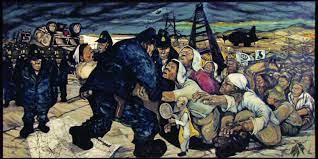
§Nakamura Hiroshi was trained by the Japan Art Alliance, a post-war group that focused on realist paintings with political themes. He covered protests on the U.S. military bases in the mid-1950s. In the small town of Sunagawa, the U.S. military planned to take land to extend the airplane runway. This order would have evicted over 100 families from the land their ancestors cared for. Naturally, the farmers protested, attracting the attention of student groups and labor unions. Sunagawa #5 depicts the protesters and police locked in violent conflict. A small priest stands at the center of the painting, facing the police. The “Sunagawa Struggle” would continue for years. In 1968, the military canceled the runway expansion. In 1977, the entire base was given back to Japan.
Nakamura depicted a 1955 confrontation in the protracted military-base protests at Sunagawa in a graphic, realistic manner that he did not always adhere to in his later political paintings. Even here, however, he introduces imaginative detail like the tiny figure of a priest standing in solidarity with local residents who were protesting the confiscation of their land to enlarge the runways at a major U.S. airfield.
Even as he was presenting such straightforward “reportorial” artwork, Nakamura was also developing an innovative pictorial strategy that, as he explained it, employed four receding points of perspective instead of the conventional single point—all aimed at composing a “close-up” at the center. He was determined to go beyond the raw visual film footage that left-wing colleagues such as the filmmaker Kamei Fumio were producing in their own critical documentation of the protests.
Georgia Patselli
sources:https://visualizingcultures.mit.edu/protest_art_50s_japan/anp1_essay02.html
https://www.humanrightscareers.com/issues/human-rights-paintings/

